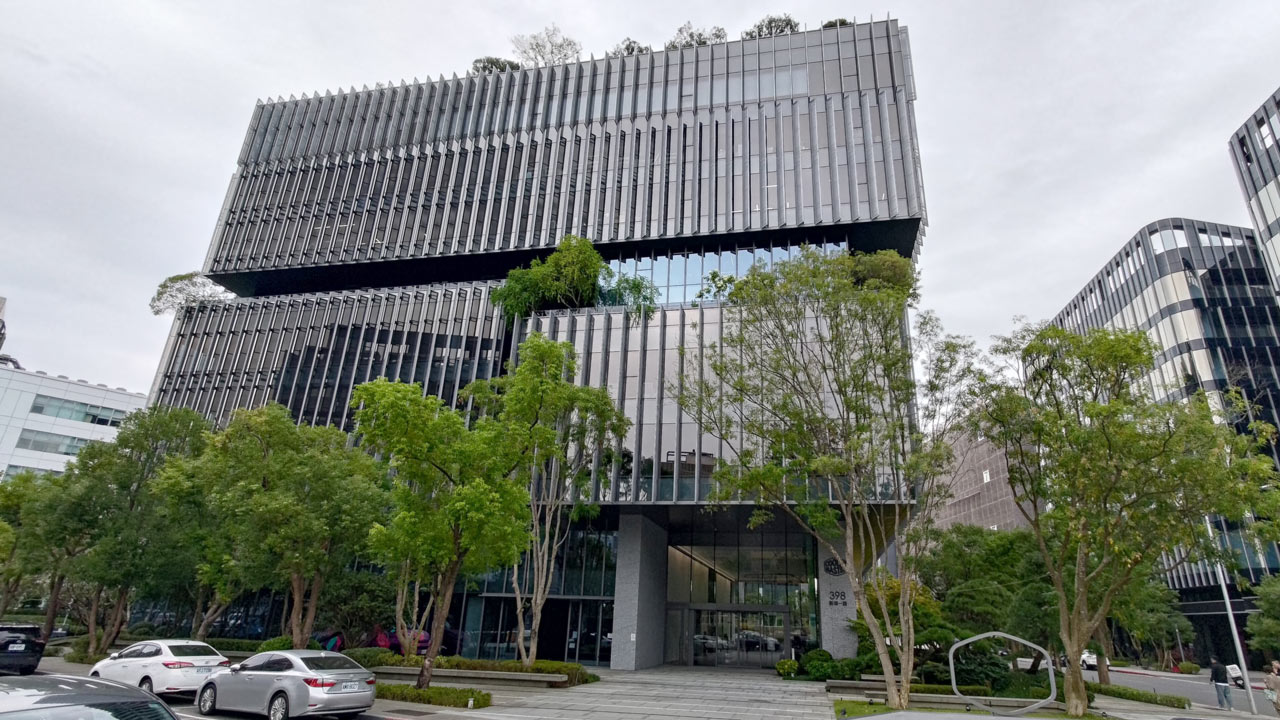
We recently visited Cooler Master's headquarters in Neihu, Taipei, as the team prepared to send piles of hardware to Las Vegas for CES 2024. The company discussed the latest trends in the PC market, including a broad industry move to support motherboards that have all of the connections on the rear and the rise of more powerful passive power supplies. The company had all of its latest products, and more, on display at its headquarters.
It is easy to know when you have arrived at the Cooler Master HQ — pulling up at the curbside in a taxi, you immediately see the substantial office block, which has been built to look like a colossal passive CPU cooler. Though we arrived and left in the daytime, we were informed that the building is lit up with RGB at sundown.
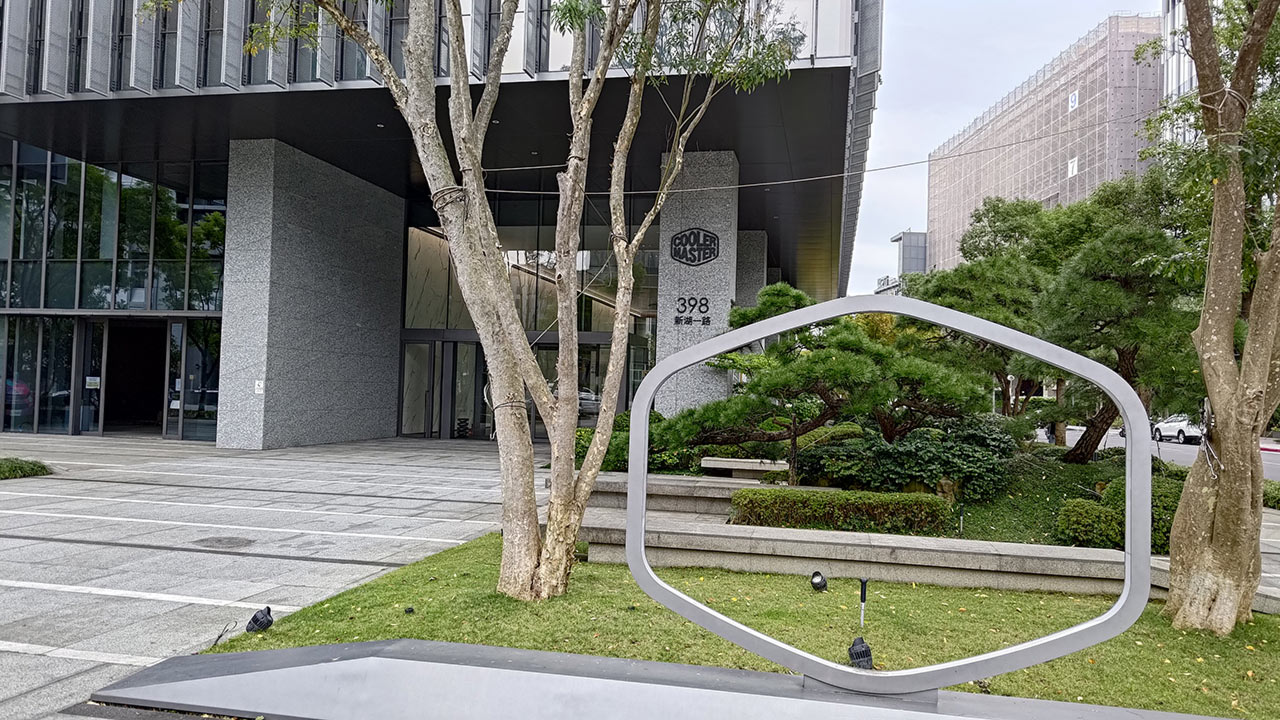
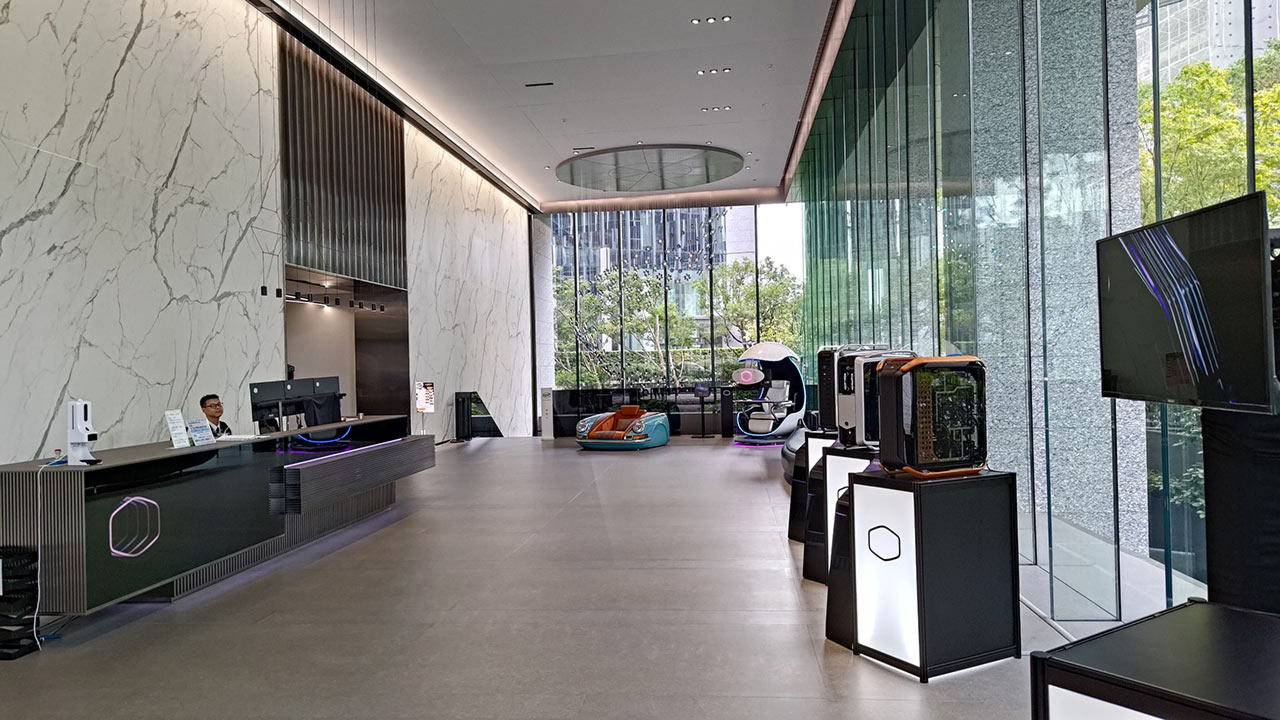
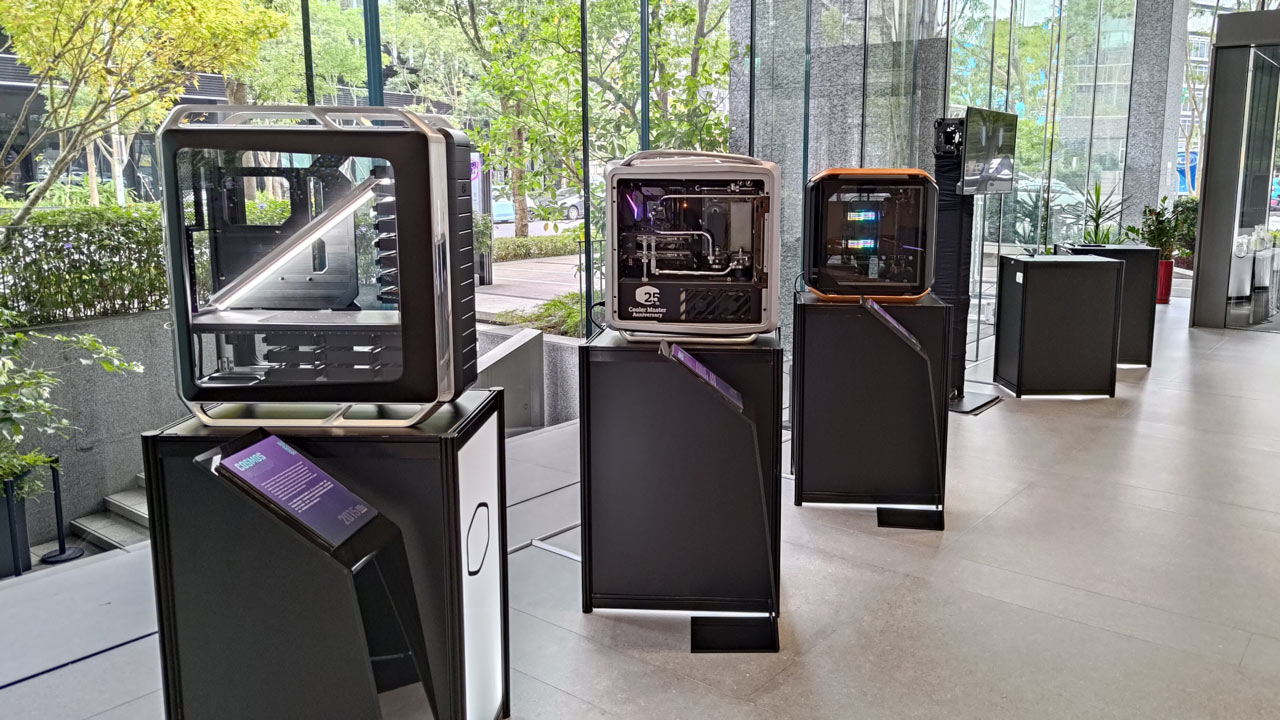
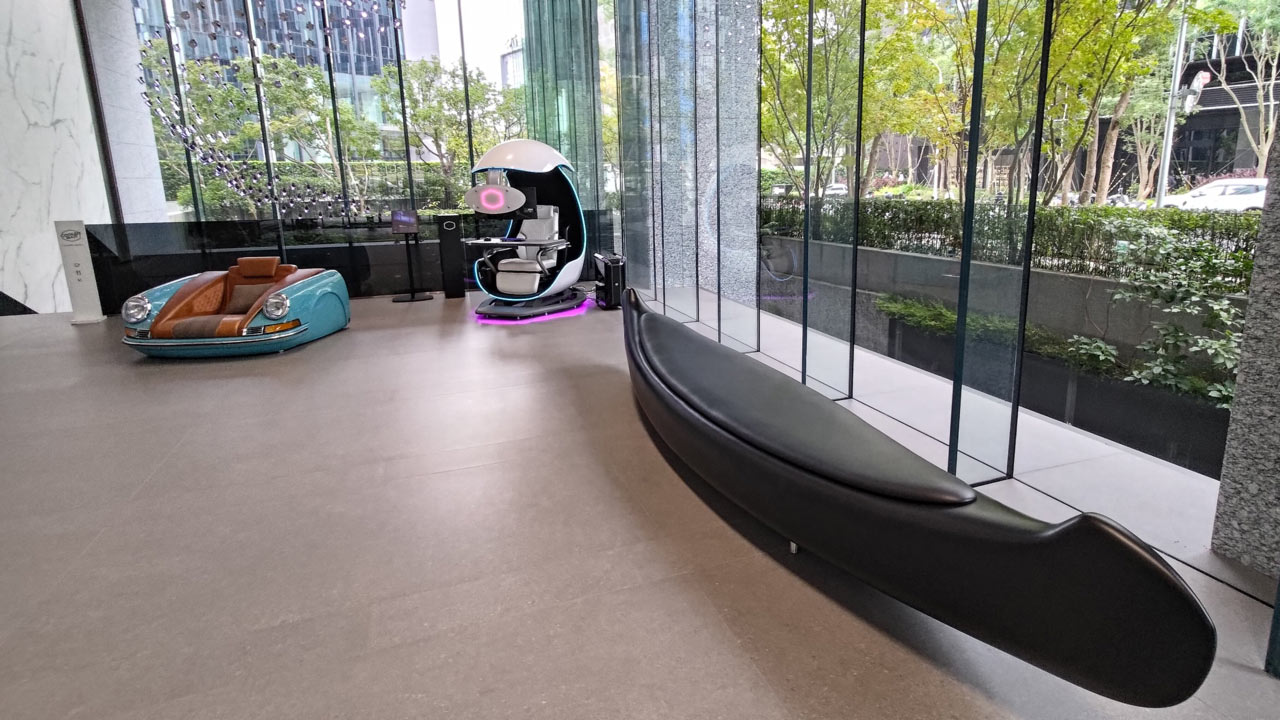
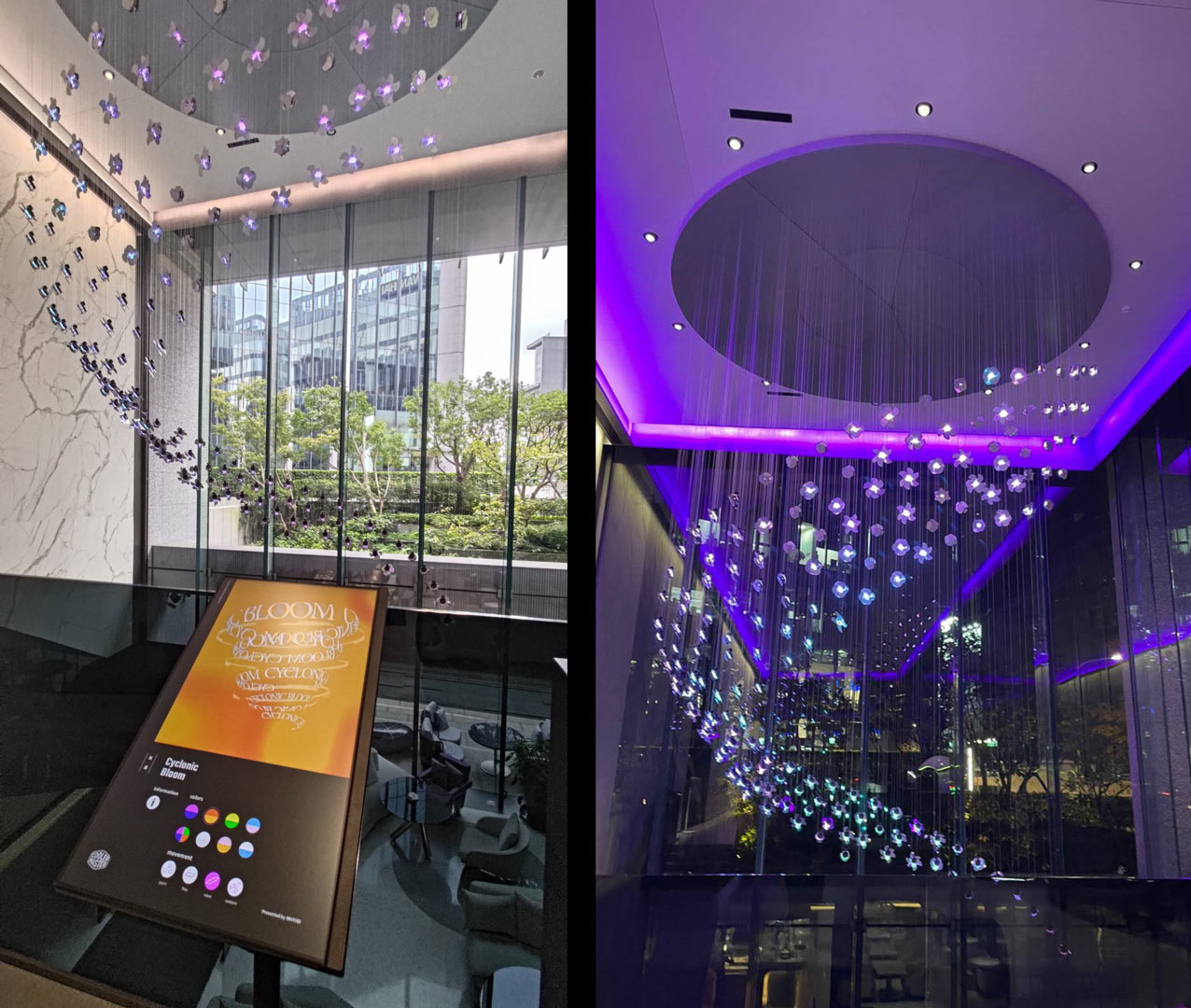
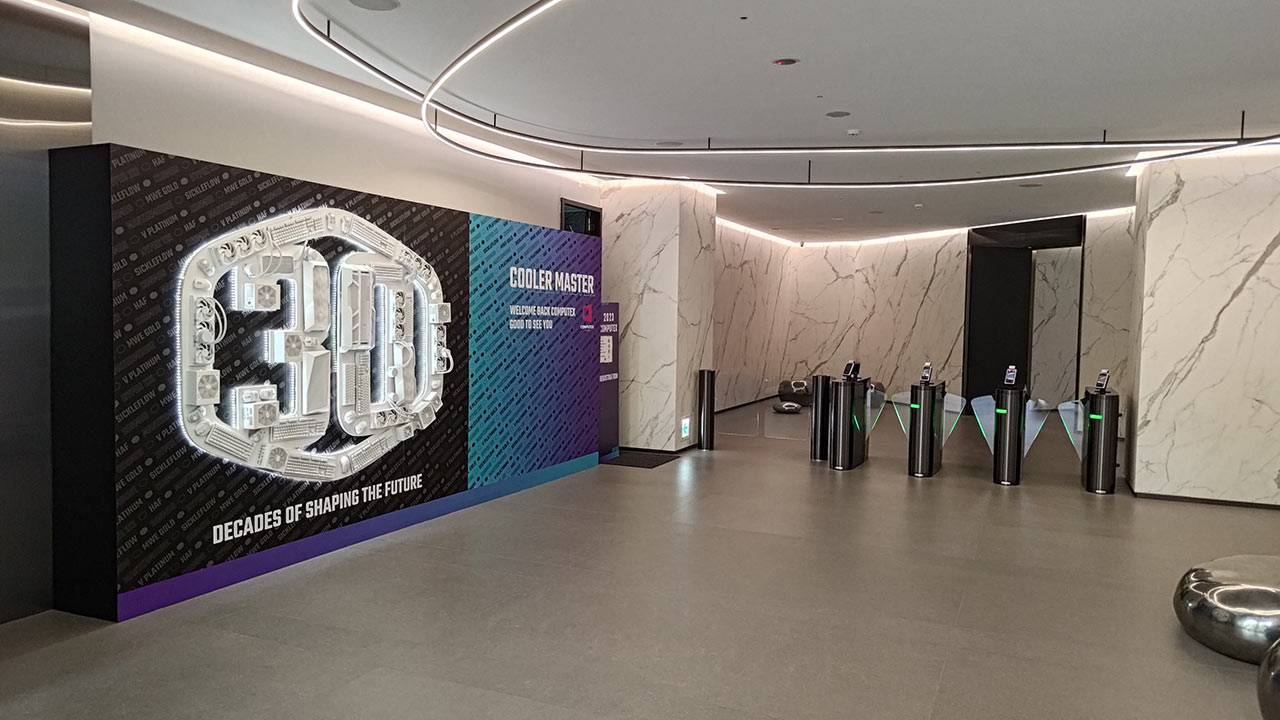
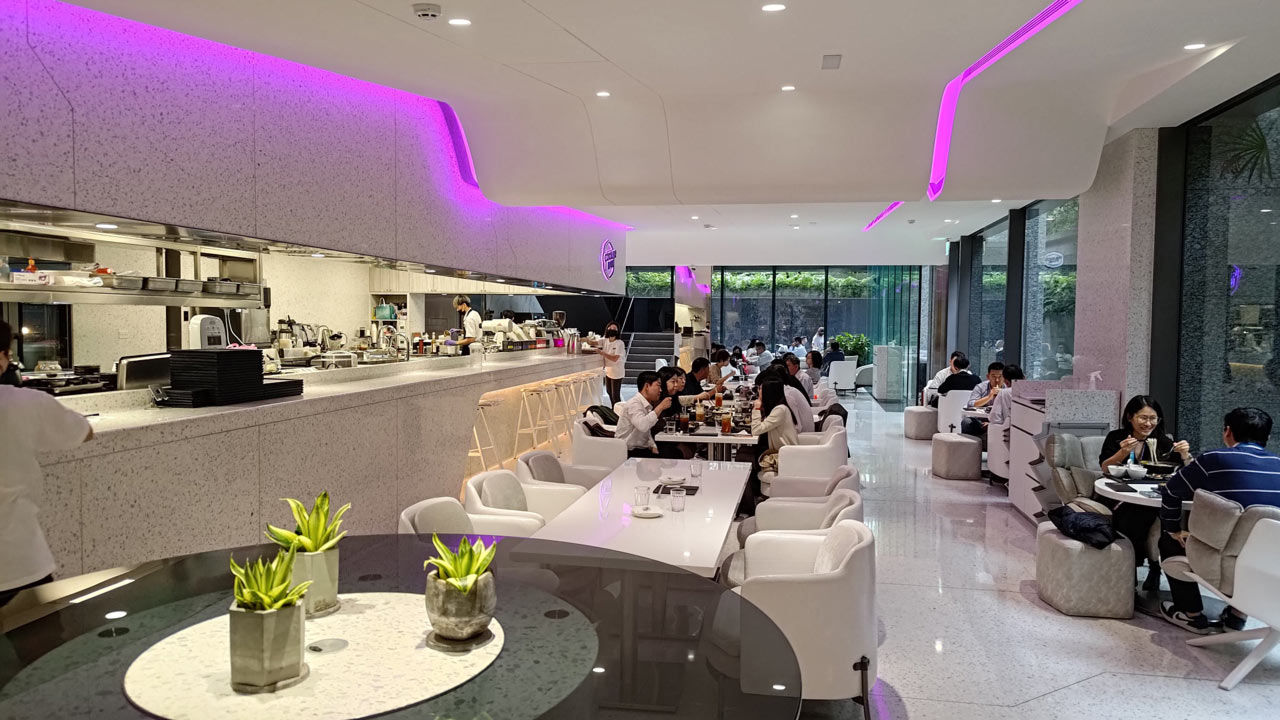
Entering the building, which has been Cooler Master’s HQ for nearly two years, you are greeted with an impressive atrium. On one side is the reception desk; on the other is a staged set of Cooler Master hardware highlighting PC cases, pre-builts, an immersive Orb X setup, and more.
Right in front of you is a chandelier-type arrangement, which turns out to be an interactive artwork dubbed the Cyclonic Bloom. If you look closely, this sizable installation is made from articulated Cooler Master fans, and they also feature lighting. A touchscreen console in front of the Cyclonic Bloom lighting feature allows visitors to change lighting and animation presets.
After being greeted by our Cooler Master contacts, our first stop, naturally, was the Cooler Café to meet with executives from various key departments and to enjoy some refreshments and beef noodles. Interestingly, Cooler Café is open to the general public, though employees rightly get a discount on food and drink. The café also features free-to-play arcade machines, a pinball table, and other geek-friendly distractions.

You may wonder how a humble PC “cases and cooling” company can afford such a prestigious HQ. The answer surprised us. We were given the impression that the Cooler Master that we know as PC enthusiasts and DIYers is just a small cog in a big machine that has extensive business interests in industrial solution areas such as AI and cloud computing, 5G telecoms, automotive and renewables, and smart manufacturing.
Some of the images below, from the firm’s fifth-floor exhibition area, show that Cooler Master heatsinks and fans turn up in all sorts of unexpected places like automobiles, e-car chargers, refrigeration devices, and, of course, servers.
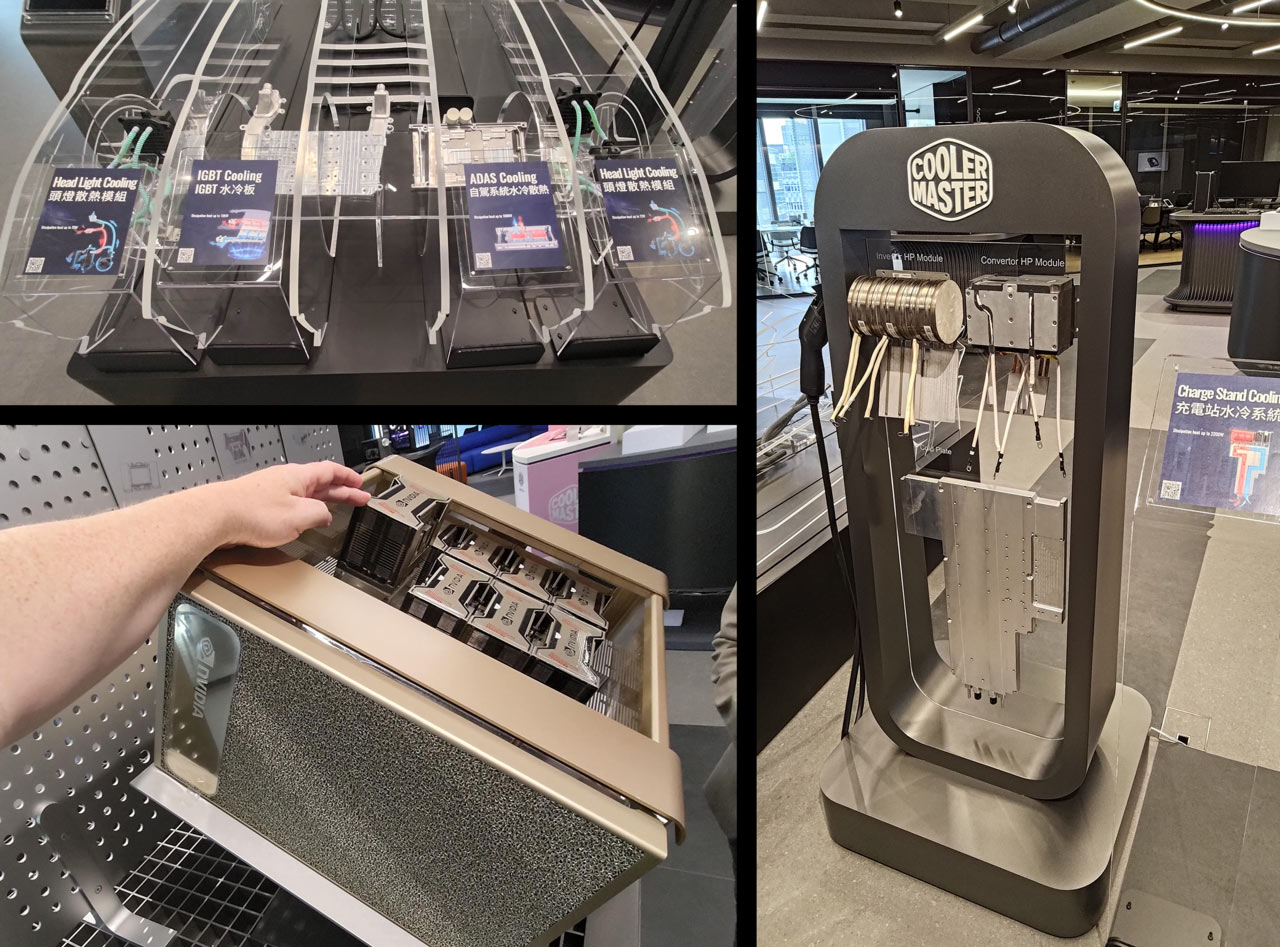
Cases (CPT = Case, Power, Thermal)
One of the most important consumer-facing divisions within Cooler Master looks after PC system case design and development and oversees power and thermal operations. The managers in this department were proud to showcase three existing and new designs, namely the Ncore 100 Max, which is a Mini ITX tower with pleasing aesthetics, the Qube 500 Flatpack DIY case design, and a traditional but imposing PC tower case called the TD500 Max.
You might have seen these devices before at Computex, for example, but the Ncore 100 Max will actually hit retail in January, and the TD500 Max should be purchasable soon, in 2024. The Qube 500 Flatpack cases are already available to purchase in three colors, and you might even find them discounted at Amazon.com, for example, priced from $85 at the time of writing.
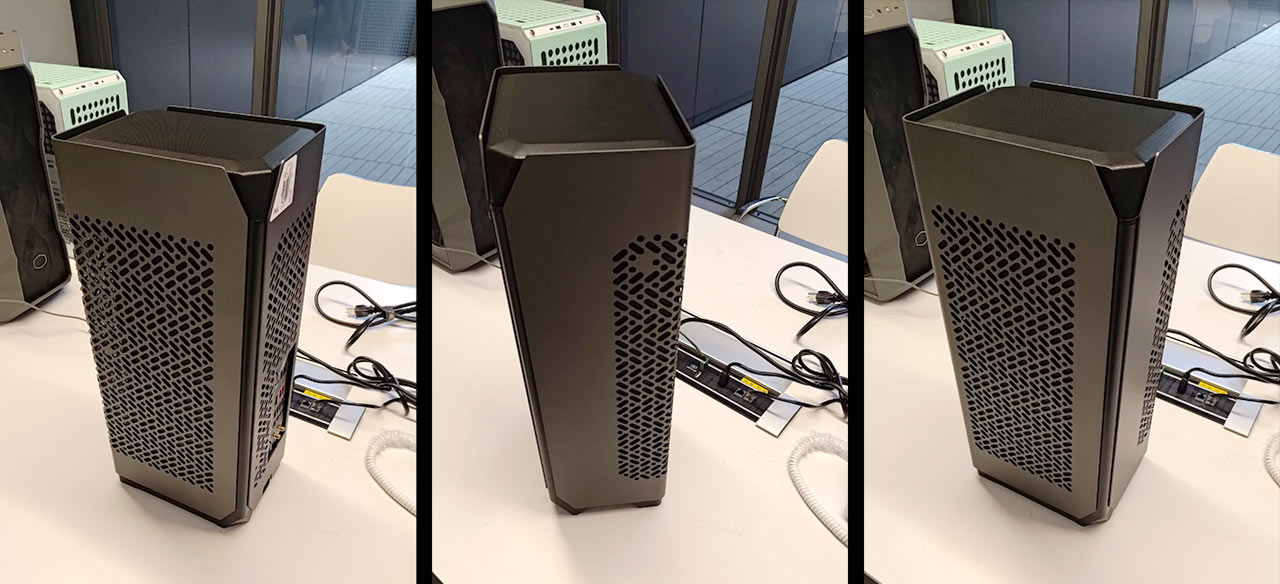
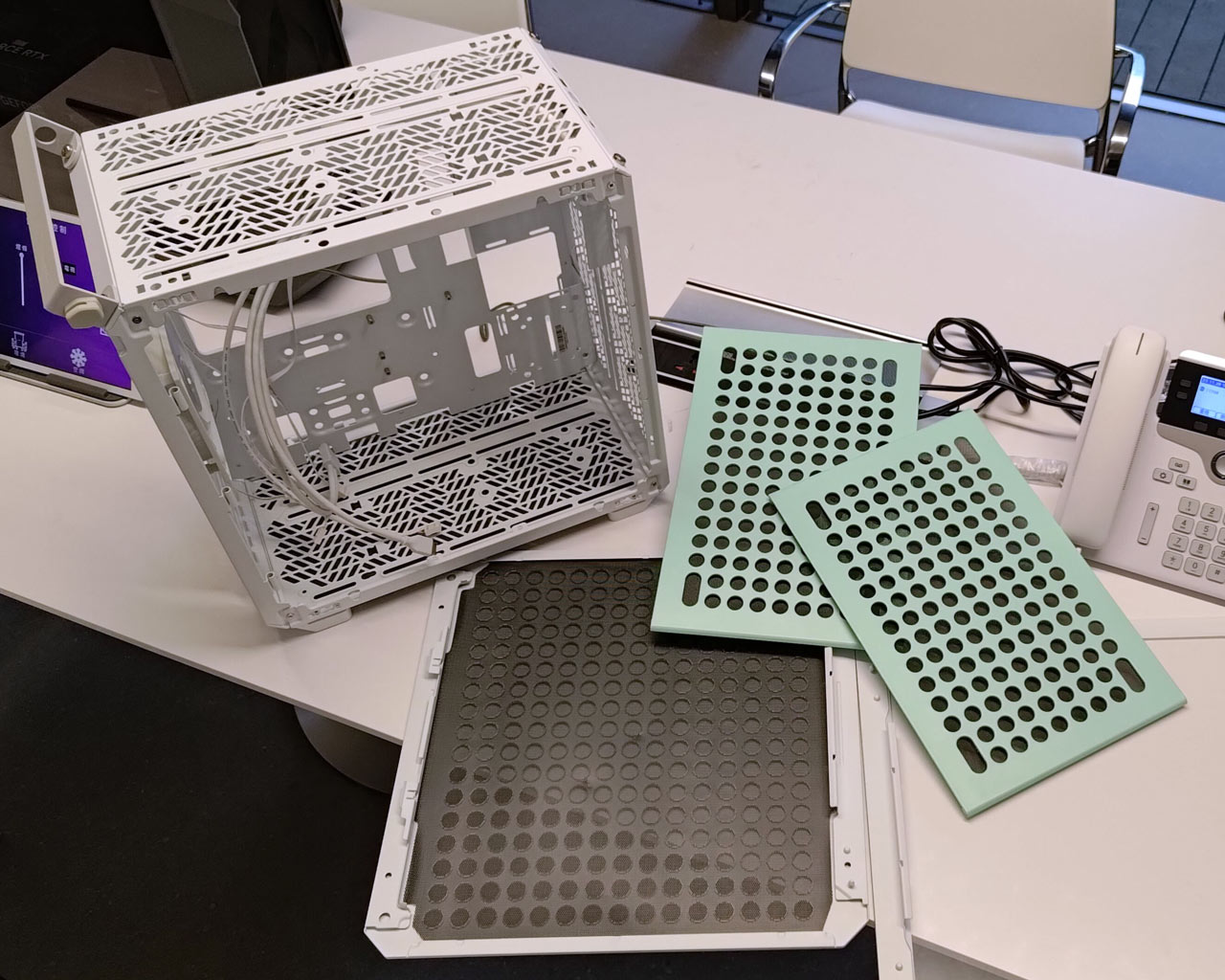
We examined each product's design, features, and construction during some hands-on time. The Ncore 100 Max is quite large and heavy for a Mini ITX case, but it still has a small footprint and is probably pleasing to the eye for those with PCs in view in their living space.
To minimize the footprint, it has to be quite tall for those who might want to fit a long triple-slot GPU. It can fit up to 3.9 slots wide GPUs, but the case side expansion option beyond 3.2 slots wasn’t ideal in the test sample, as it seemed to encroach on the back panel connectors. This $379.99 product isn’t just a case; you also get an SFX 850W PSU plus a 38mm radiator liquid cooler and riser cable in the box.
Cooler Master’s TD500 Max is impressive thanks to the capacity, flexibility, PSU shroud with built-in screw-keeper, and pre-routed cables, making this an airflow-friendly mid-tower case for DIY. Moreover, it seems very easy to build a very slick and tidy PC from this foundation which again features a pre-installed 360mm / 38mm liquid cooler and 850W Gold-rated PSU. Cooler Master doesn’t have pricing to share at this time, though.
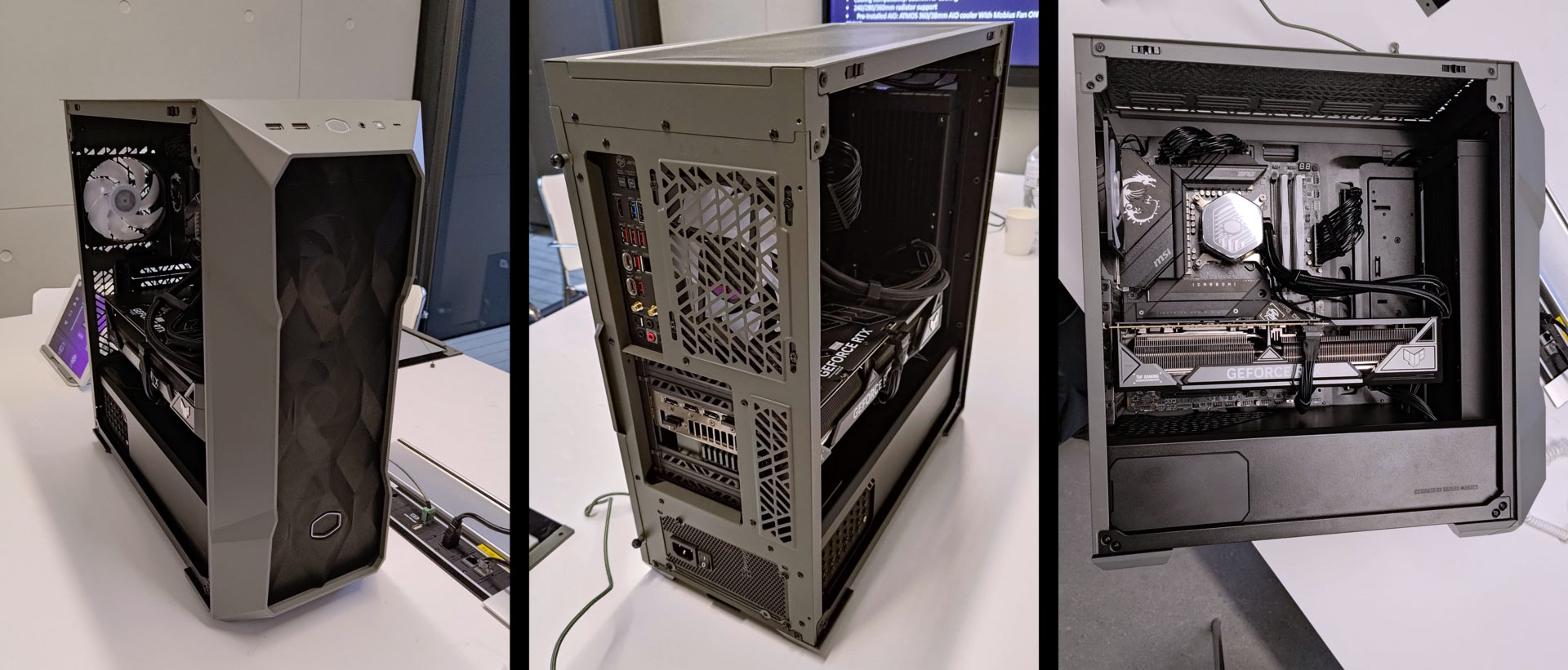
Cooler Master has interesting ideas about the latest and upcoming PC case trends and some thoughts about trends that are sliding out of fashion.
The departmental managers told us that several trends are in the ascendancy: aquarium-style cases with lots of glass, integrated display cases, high-end showcase chassis, plus designs with tasteful RGB lighting. Case trends on the wane include designs featuring ‘old school’ RGB, classic towers – due to modern component sizes, and pure workstations due to the host of attractive alternatives now available.
Cases: the back-plug tide is coming in
The positive trend predictions also include back-plug motherboard-compatible cases. Bruce Kao, the general manager of the CASE BU, had quite a lot of thoughts to share about the impending wave of back-plug motherboards. Asus calls these the DIY APE motherboards, MSI refers to them as Project Zero motherboards, and Gigabyte calls them Project Stealth motherboards.
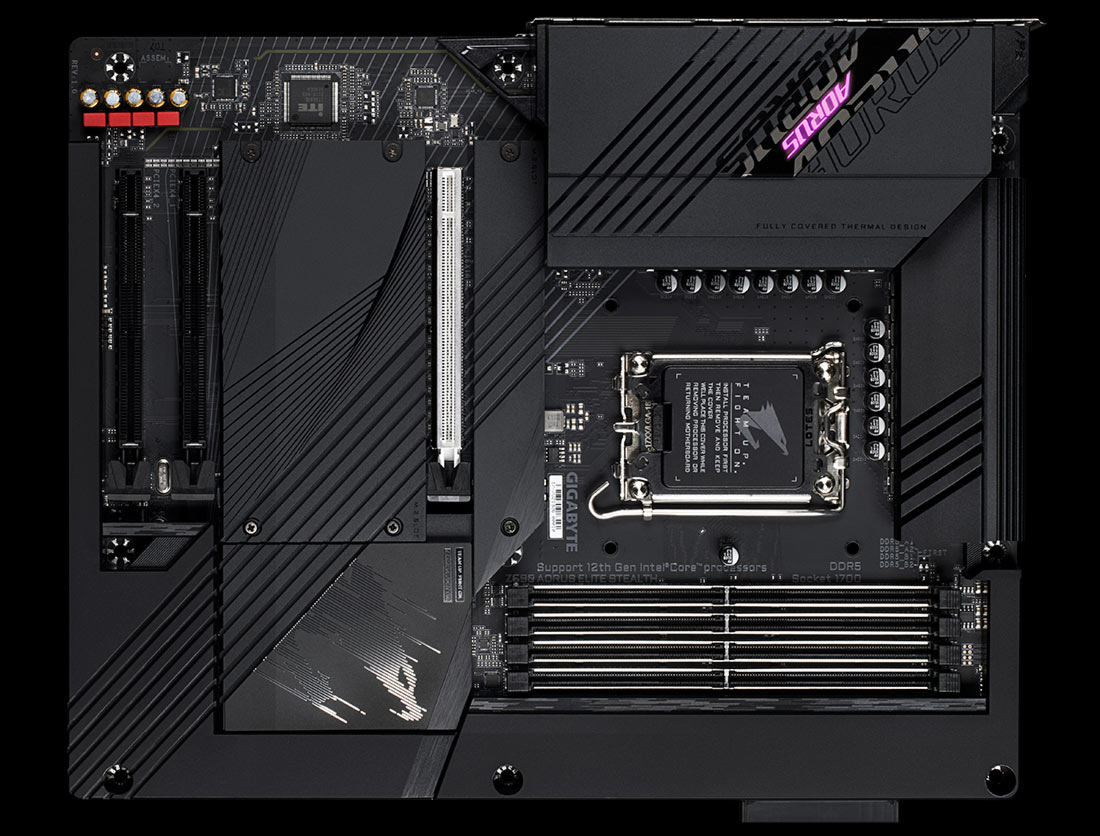
Kao says that supporting back-plug motherboards will be very important in 2024. Cooler Master has over 100 case SKUs in its portfolio, and it would require a lot of work to re-tool for both traditional and back-plug motherboards. However, starting from CES 2024, all-new case designs will support all the latest ATX / mATX size back-plug motherboards from Asus, MSI, Gigabyte, et al.
Cooler Master is enthusiastic about making cases for the new back-plug motherboards as it is believes the PC build process will be made easier by the new DIY paradigm. Moreover, the simpler, cleaner, more beautiful, and improved airflow precipitated by back-plug motherboards is expected to reignite interest and consumer spending in PC DIY.
Cases: materials
We also talked about case design and materials. Today’s case and system customer wants more colors and customization options than ever. Cooler Master sees this trend, and you can already get more colors and select premium materials with some of its wide range of cases and systems. This movement can also be seen with rival brands, and it is a broad industry trend.
During our tour, we saw some interesting work being done with case materials and finishes. Based on what we saw, more exteriors featuring leather, wood, and bamboo alongside traditional PC case materials like metal, glass, and plastic are coming. There is also some momentum behind adopting more eco-friendly materials. Lastly, we are glad to see that imaginative materials won’t be limited to prestige-level products.
Power
The Power team wanted to show us some new and upcoming PC power supplies from Cooler Master. There appeared to be several trends pushing forward PSU development at the company, and these were: quieter and passive PSUs, delivering more watts for silent and SFF builds, offering more 12VHPWR connectors, and providing white versions of new and upcoming PSUs.
We reported on the Cooler Master X Silent models and X Mighty PSUs in early November. However, now we have more in-depth information about the trio of PSUs from this family, dubbed the X Silent Edge Platinum (850W and 1100W), the X Silent Max Platinum (1300W), and the X Mighty Platinum (2000W).
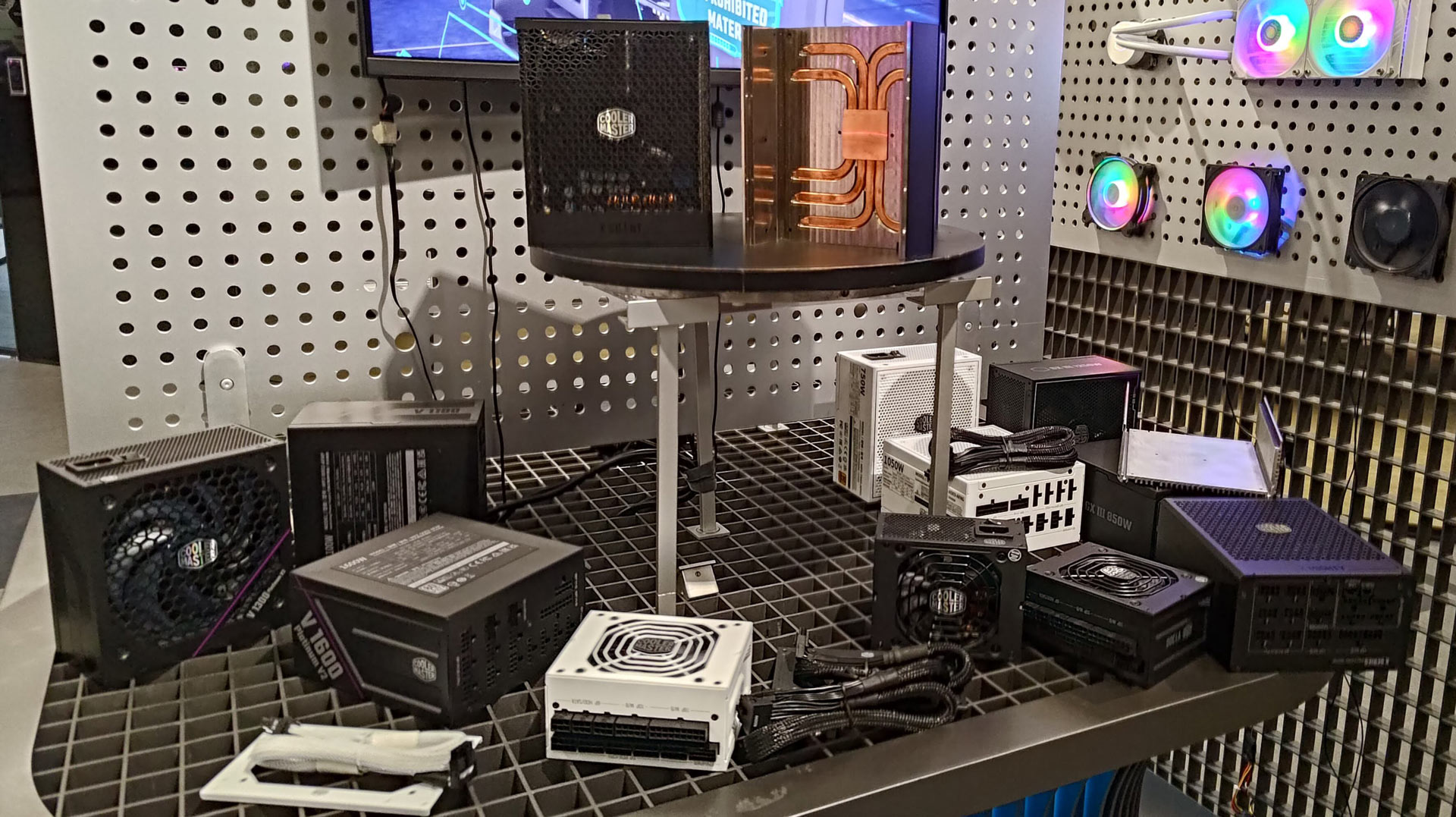
Some hands-on time with the fanless Cooler Master X Silent Edge Platinum 1100W, with its substantial metal cooling block threaded with heat pipes, really brought home its weighty design. It is claimed to be the first fanless 850W / 1100W PSU for totally silent computing. As well as the innovative aluminum PSU case with heat pipes pictured, Cooler Master implemented some custom modularized thermal components, which it is keeping out of public view for now.
The identical-looking X Silent Max Platinum 1300W has a similarly thick aluminum case, but it eschews the heat pipes as there is a fan in the design. Cooler Master says it still earns the ‘X Silent’ moniker thanks to its Mobius sub-20dB high-pressure semi-passive fan. Again, we saw some key cooling components from the modularized thermal structure inside.

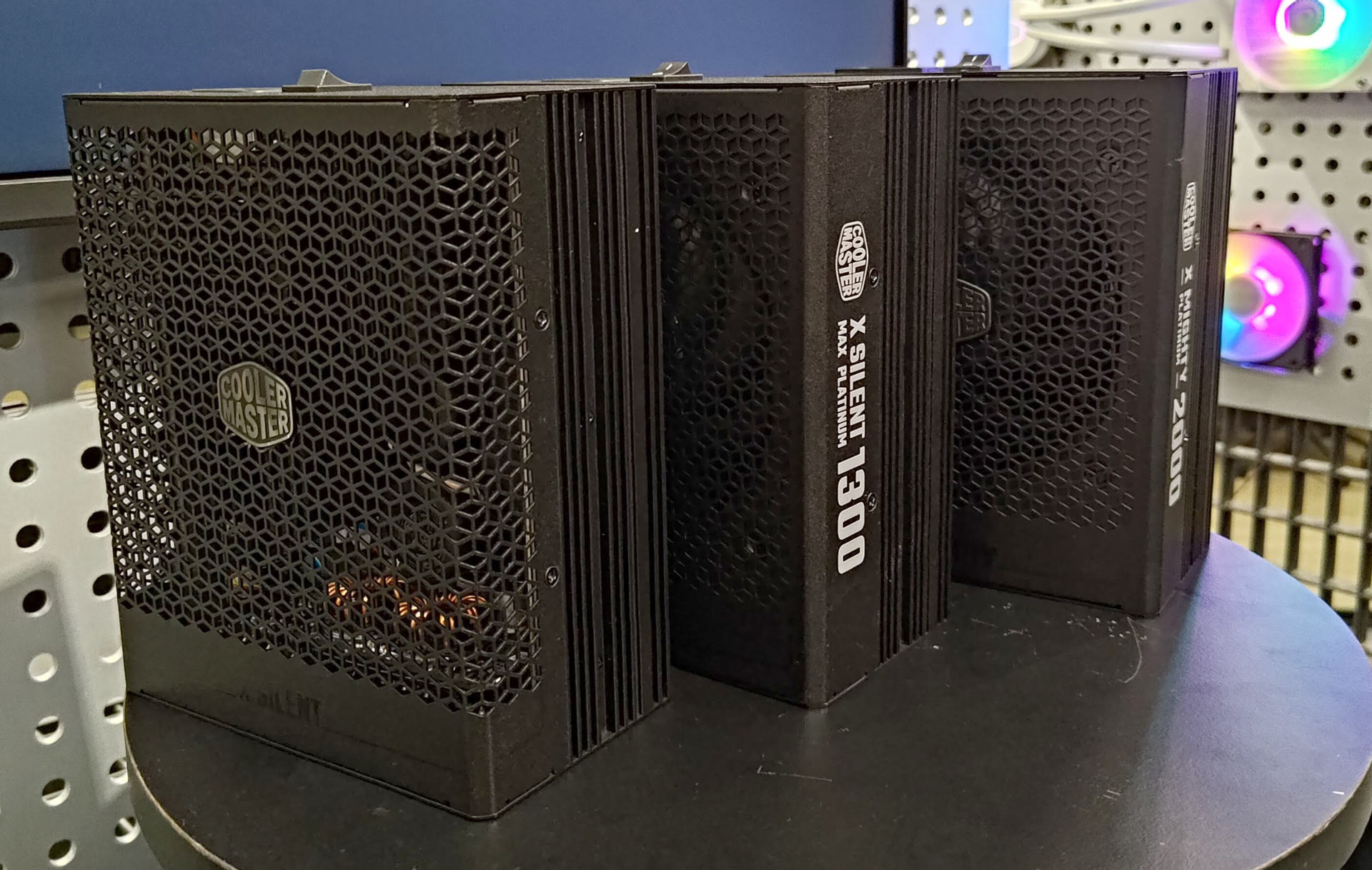
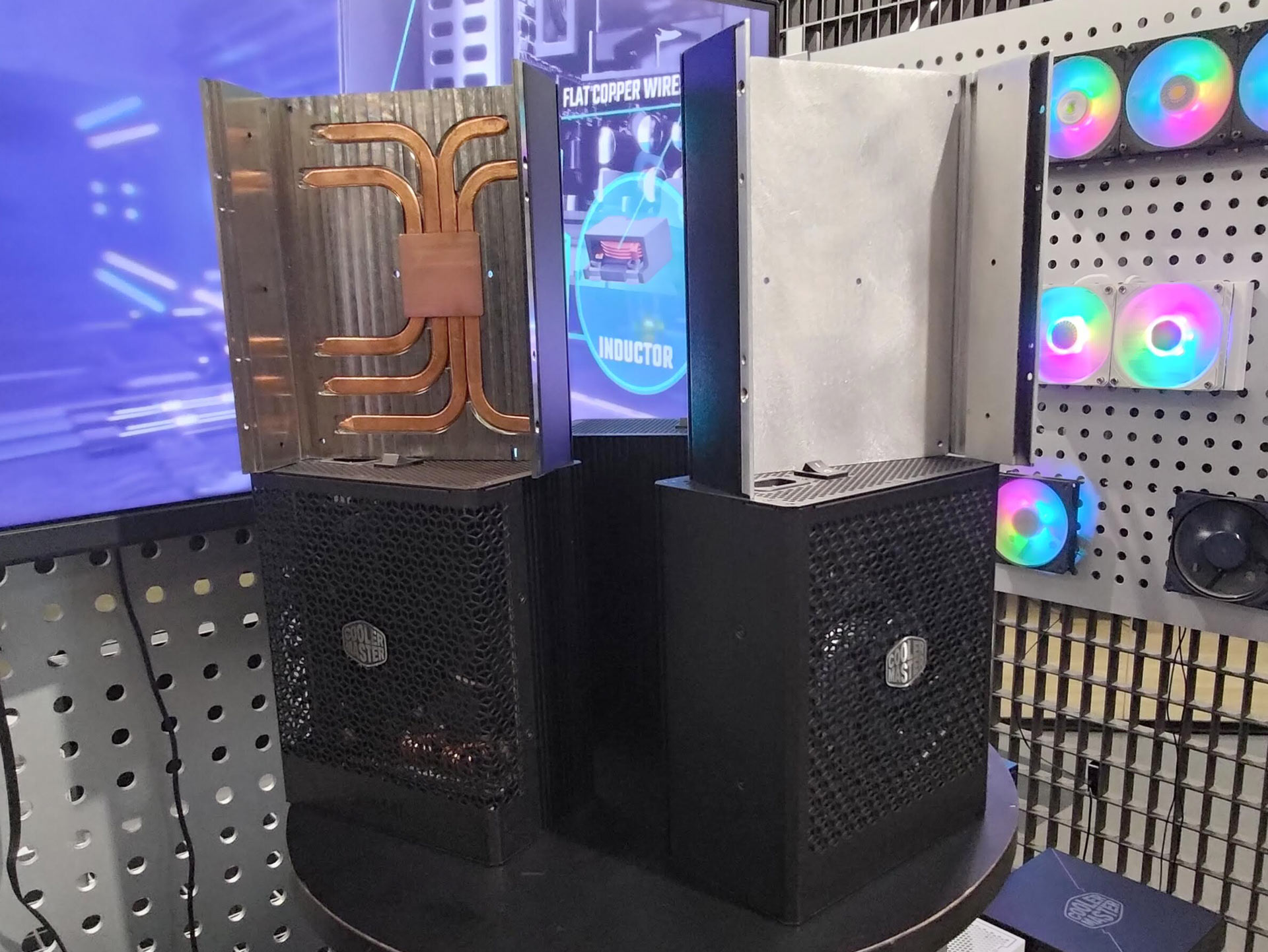
The final member of this family, the X Mighty Platinum, again hides an advanced thermal structure inside. A large semi-passive fan is employed here, too. Buyers of the X Mighty Platinum will have two 12VHPWR connectors/cables available.
All the members of this family include common features such as a digital monitor interface, integration with the MasterCTRL software, 80 Plus Platinum certification, ATX 3.0 support, plus purportedly durable 12VHPWR cable(s) with 90-degree connector to one side. Moreover, all these PSUs have long warranties: 15 years for the Silent models and ten years for the Mighty ones.
Cooler Master’s V Platinum series power supplies are also set for a revamp with a crop of V2 models. On trend, higher-power models will be on the way, with 1600W, 1300W, and 1100W models. The cooling performance will be boosted with ultra-quiet ring-blade Mobius fans featuring high-pressure characteristics, oil-bearing construction, and anodized heatsinks.
Higher power models in this range will also be graced with twin 12VHPWR connectors, as pictured. Also, the images show the bundled twin-pack of angled 12VHPWR connectors with these PSUs. The Cooler Master V Platinum V2 family all come with 12-year warranties.
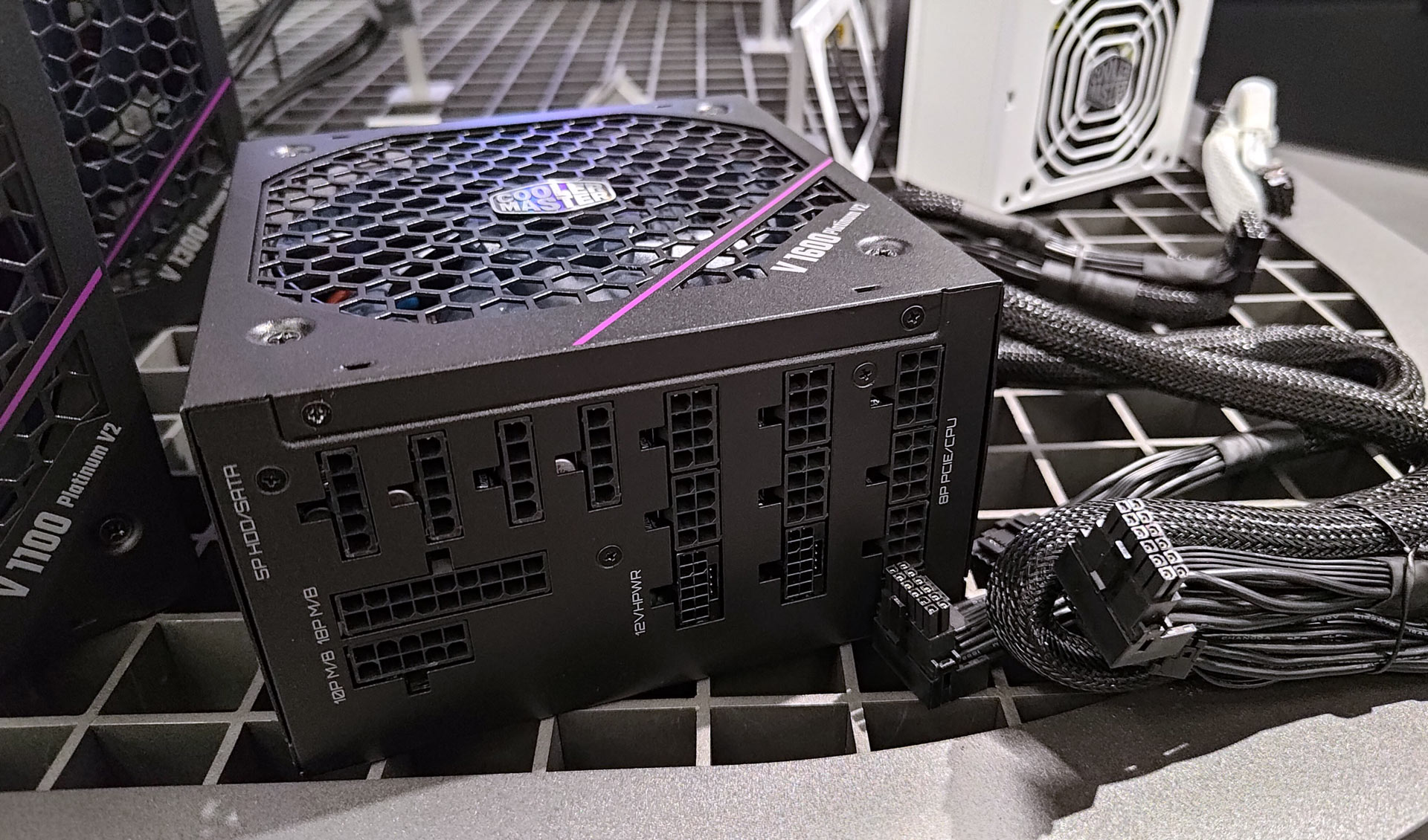
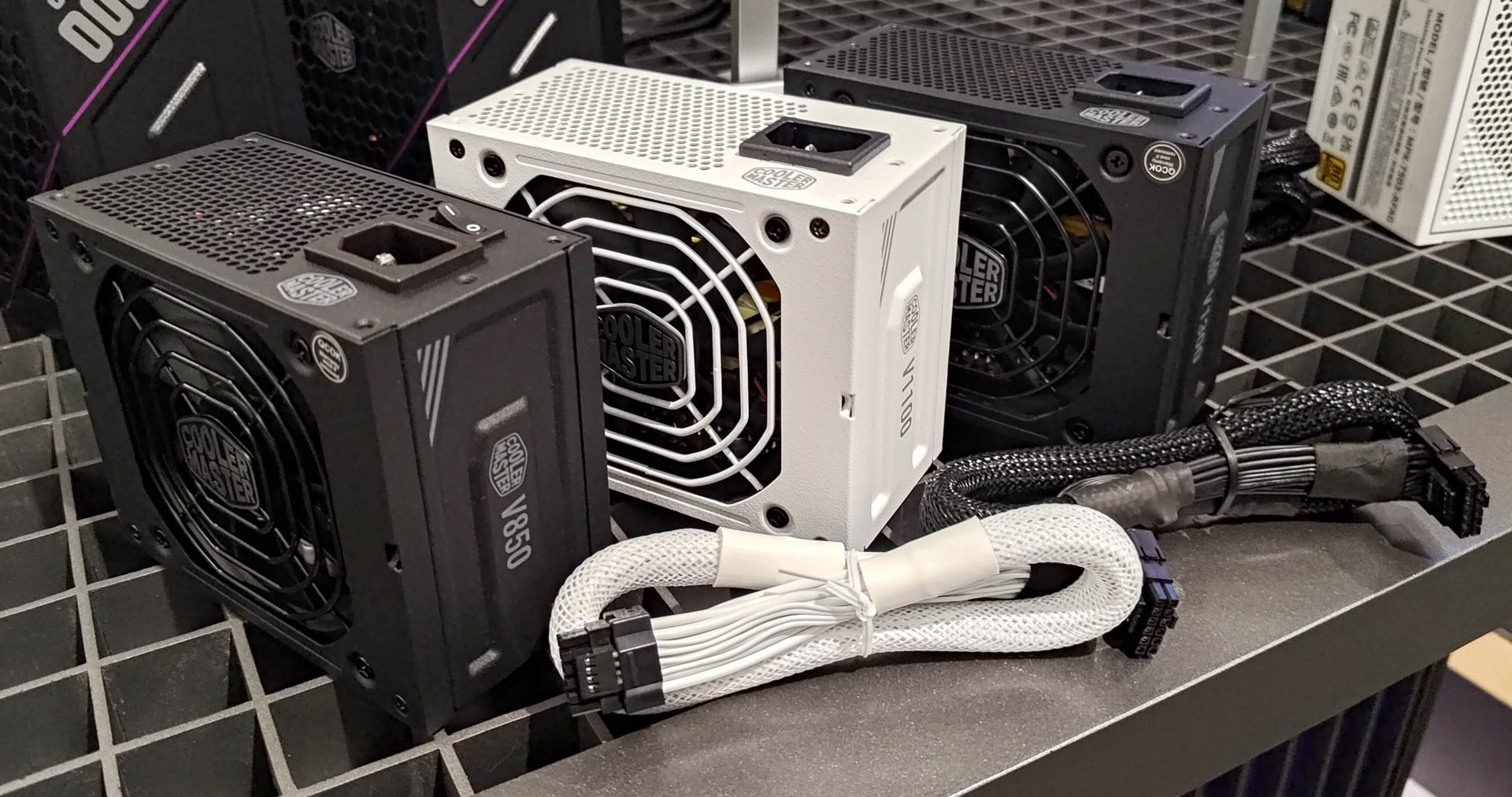
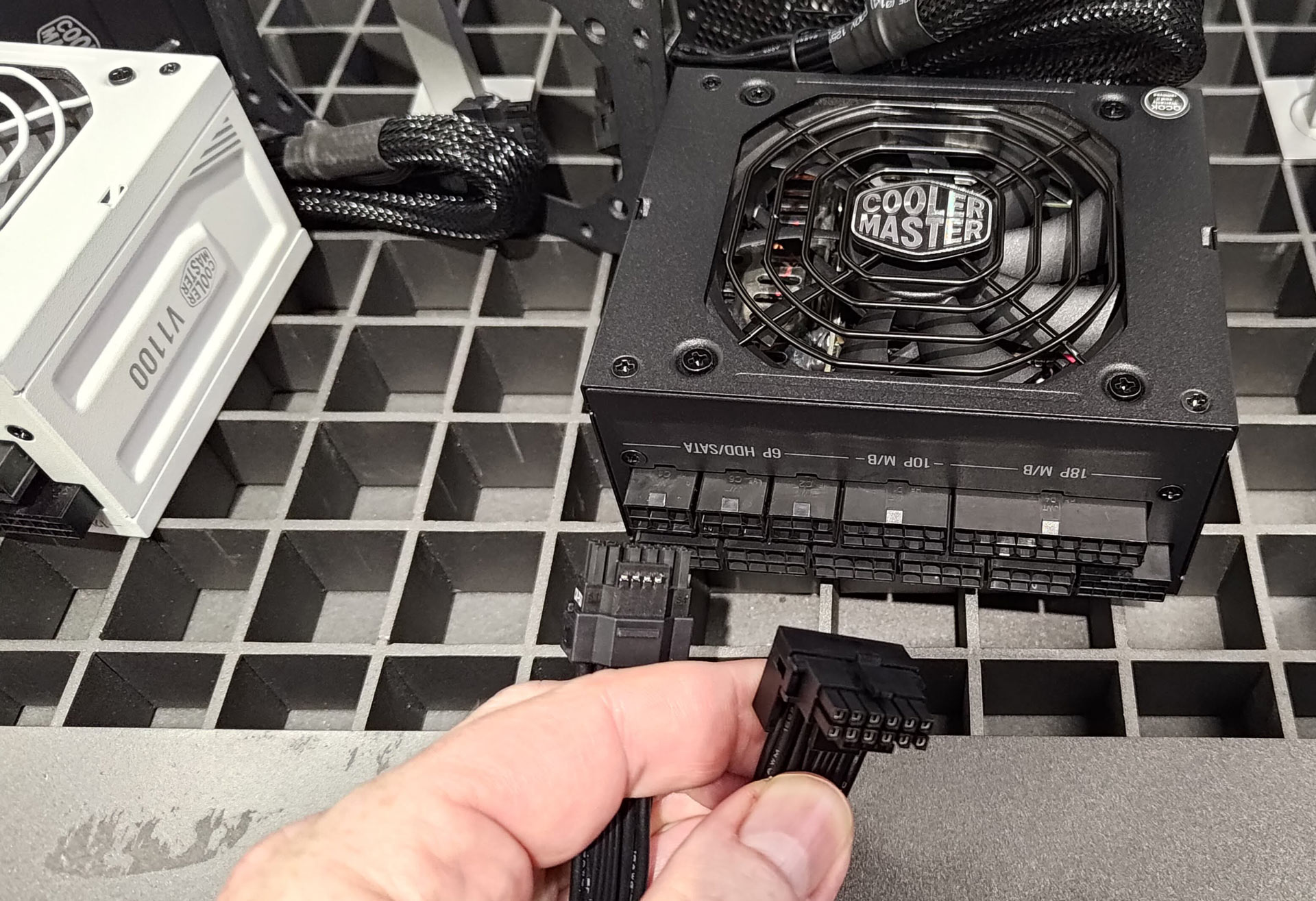
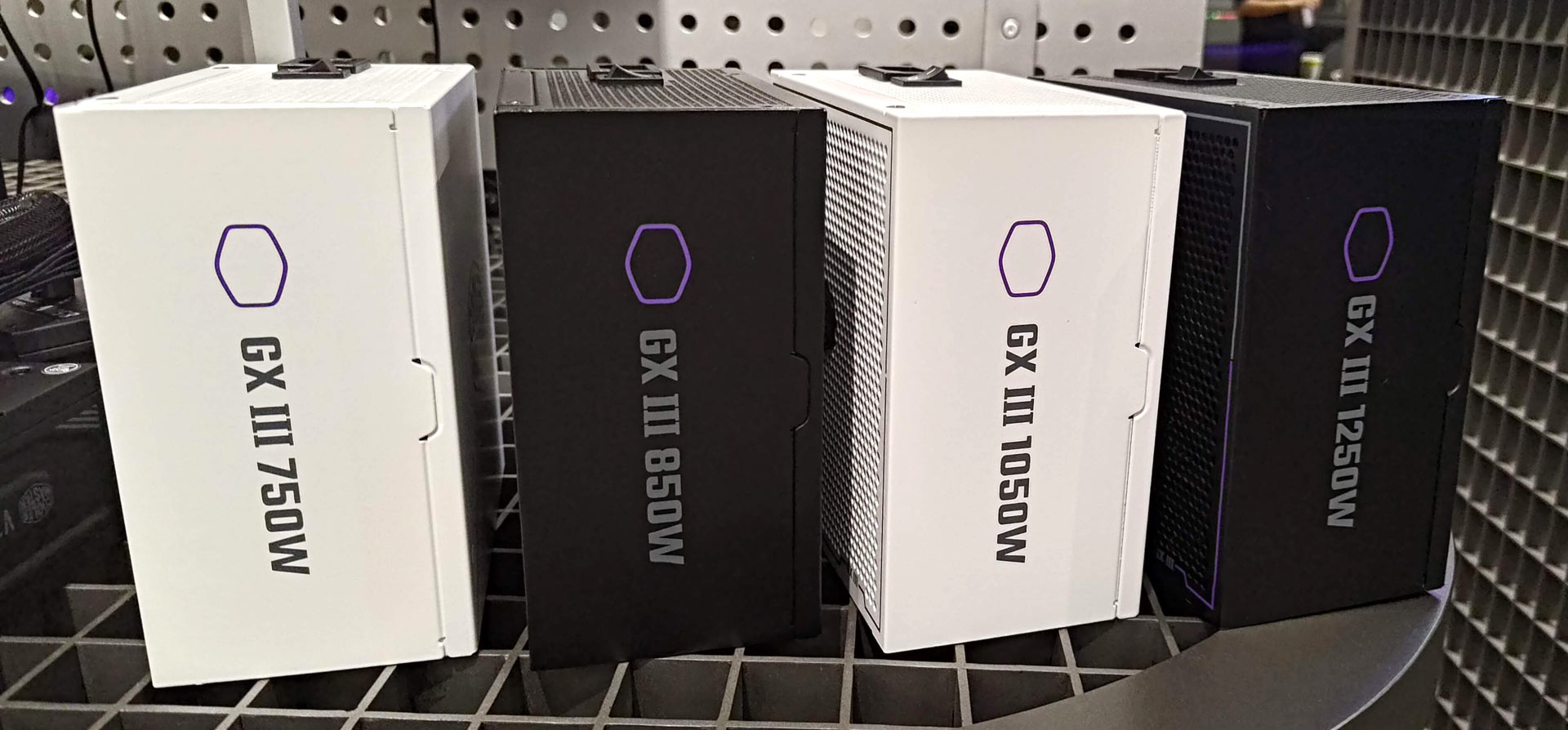
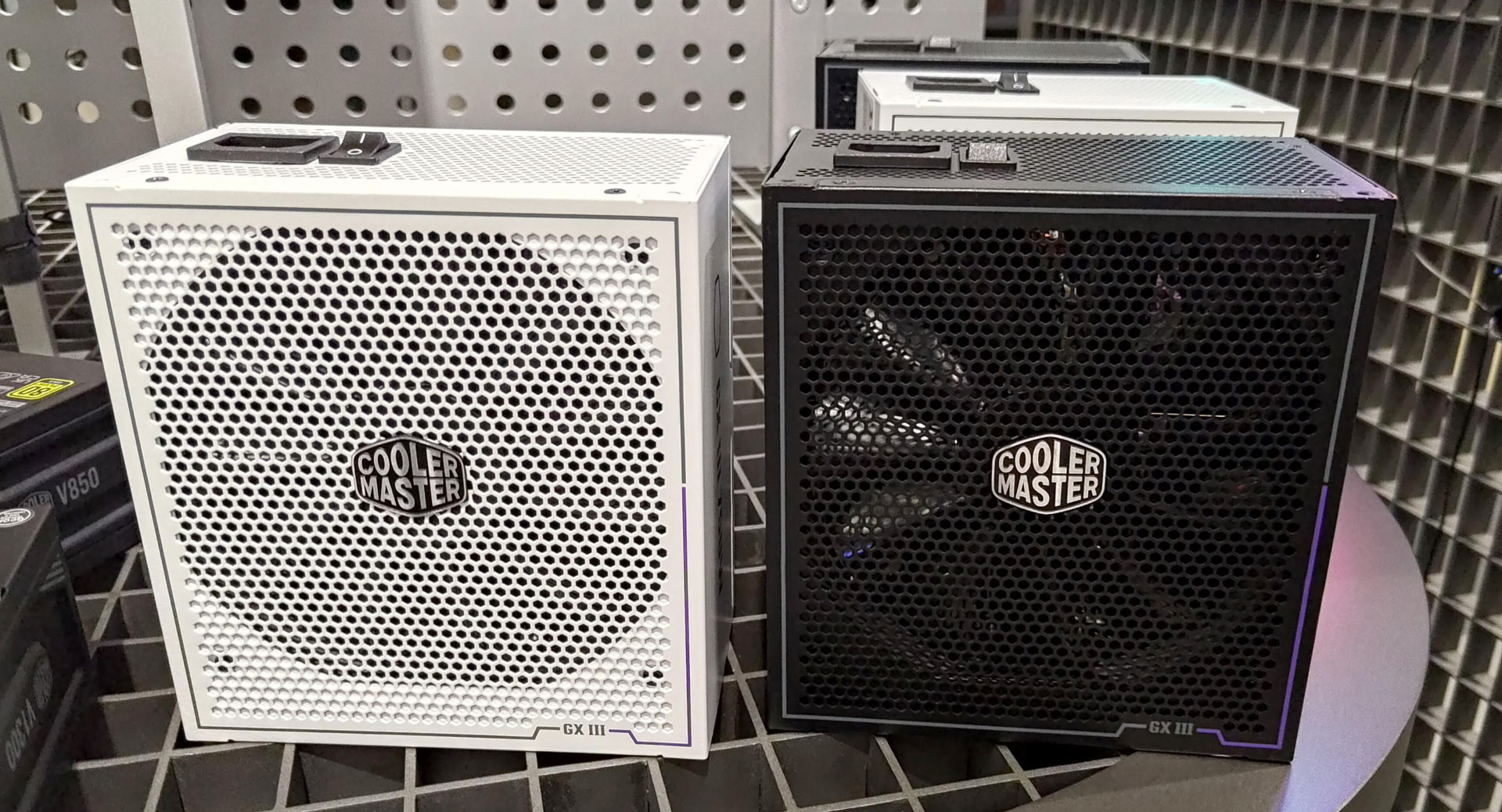
As mentioned above, white PSU options are also set to grow. Cooler Master showed us some attractive new white versions of the 80 Plus Gold rated GX III Gold family and the compact and bijou V SFX Platinum and Gold series PSUs delivering up to 1300W and sporting fetching white attire.
All these new PSUs also feature anodized heatsinks, said to boost cooling by up to five degrees Celsius, plus color-matched 90-degree 12VHPWR connector cabling. Cooler Master provides 10-year warranties with these PSU families.
CMIMX
Cooler Master’s CMIMX business unit is concerned with delivering more immersive experiences. At present, the unit seeks to succeed in its immersion goal without stepping into the world of AR, VR, MR, XR, and similar technologies that require users to wear a display on their face. This more traditional PC monitor-based philosophy remains for now, but a future step into XR isn’t ruled out as a matter of policy.
During our visit, we got to test immersive experiences with hands-on time and sat inside the latest Dyn X Dynamic Racing Experience. Playing F1 22 in this setup was indeed immersive, as Cooler Master had equipped the simulator suite with some of the best peripherals, sound, and haptic feedback.
Readers should expect to see some interesting enhancements to the Dyn X in the coming months. If you’ve thought about ways this product might be improved, perhaps Cooler Master has thought of them too…
The immersive experience when sitting in the Orb X Gaming Throne was quite a contrast, and it was interesting to hear that this futuristic computing station isn’t all about gaming; it is quite an attractive and very comfortable pod for getting work done. Cooler Master’s Orb X is thus marketed outside the gaming sphere, aiming to attract remote workers and luxury high-tech consumers.
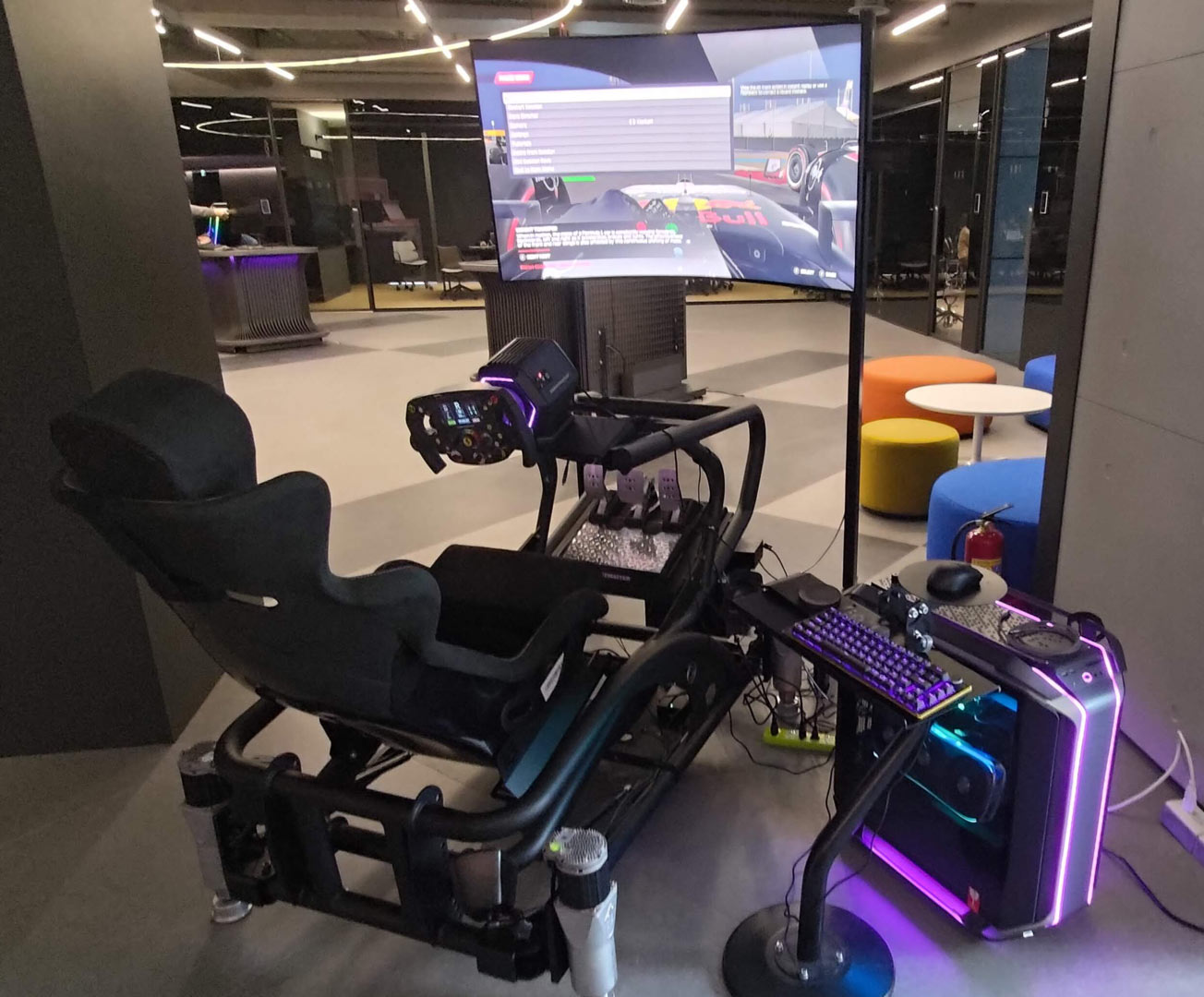
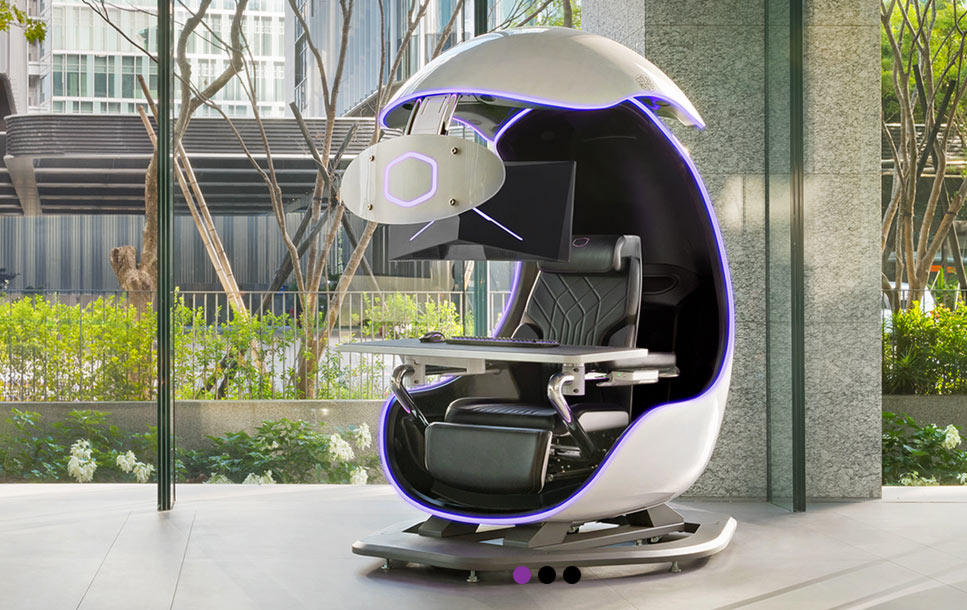
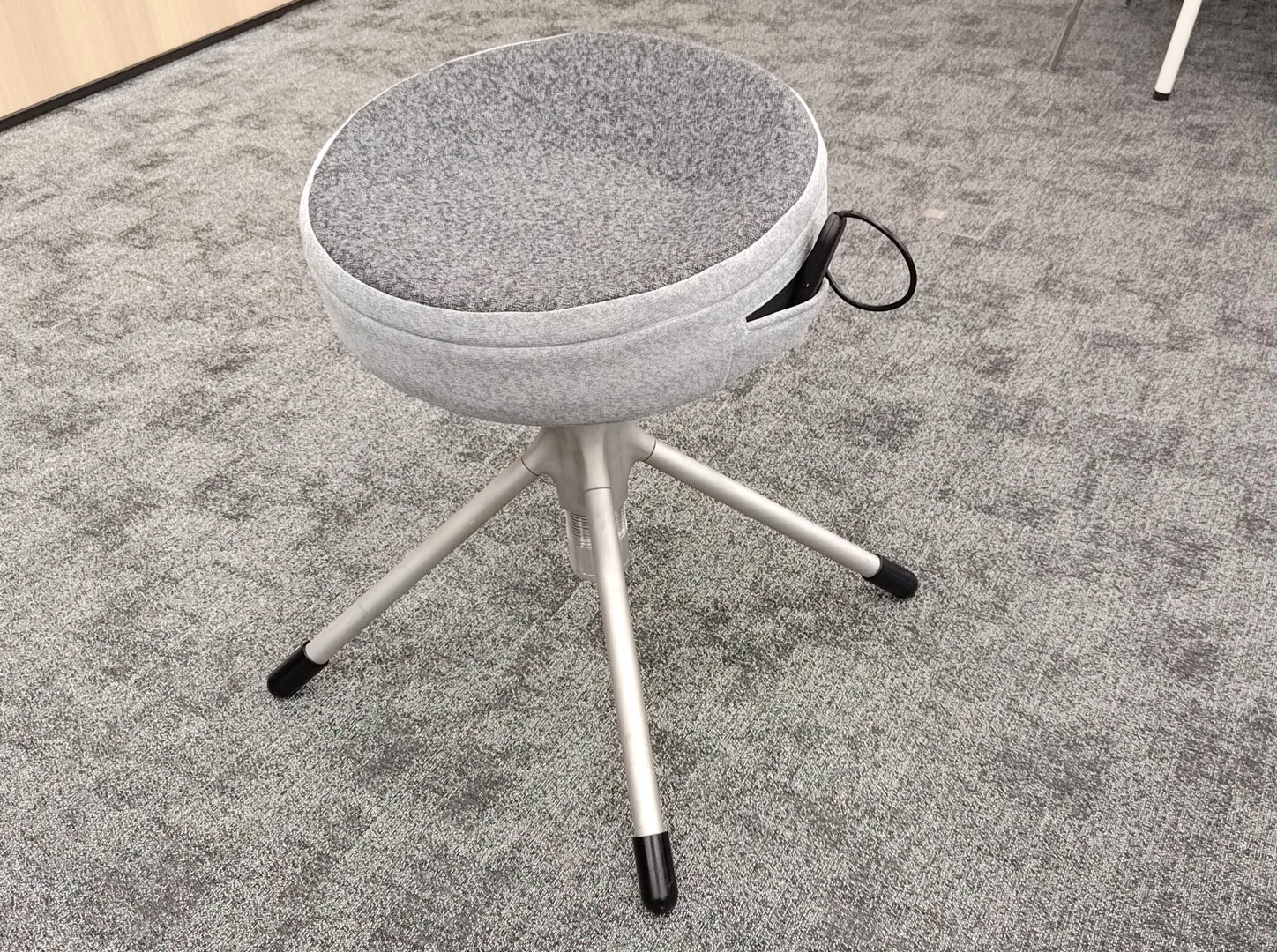
The last product we saw with the senior marketing manager at CMIMX was the Throne X drum stool. This is something of a curiosity, as far as PC enthusiasts go, as it is a haptic stool to help musicians keep perfect time, like a metronome in your seat.
Advanced System Products
Cooler Master’s Advanced System Products business unit handles the firm’s pre-built PC products. Though the unit might be best known for the designs that make a big splash at trade shows, like the Shark X and Sneaker X, it also has some sober and carefully designed premium mainstream PCs in its portfolio, like the HAF5 Pro and Cooling X systems.
The business unit divides its attention across three portfolio areas, like 'Make it Yours,' which is the mainstream portfolio of advanced systems, 'Be Different,' which is the portfolio focused on more artsy designs, and 'Be Excellent,' which is focused on Performance and B2B solutions.
Visiting the Advanced System Products department, we saw all the above-named systems and various cooling components on display. We heard from the Advanced System Products marketing lead about upcoming refinements to designs like the Shark X. It was also notable that the creatives in this department continued to work on crazy new designs – one of which we couldn’t photograph and share. Stay tuned for CES 2024 next month.
Among the well-known but extraordinary Shark X and Sneaker X systems, we were intrigued to see a similar quality motorbike PC, which you can see in the photo gallery below. This isn’t a consumer product, though. We were told that the Cooler Master boss commissions custom PCs occasionally in designs that tickle his fancy, and this is one of those projects. It is nice to know that custom PC design appreciation goes right to the top of the company.
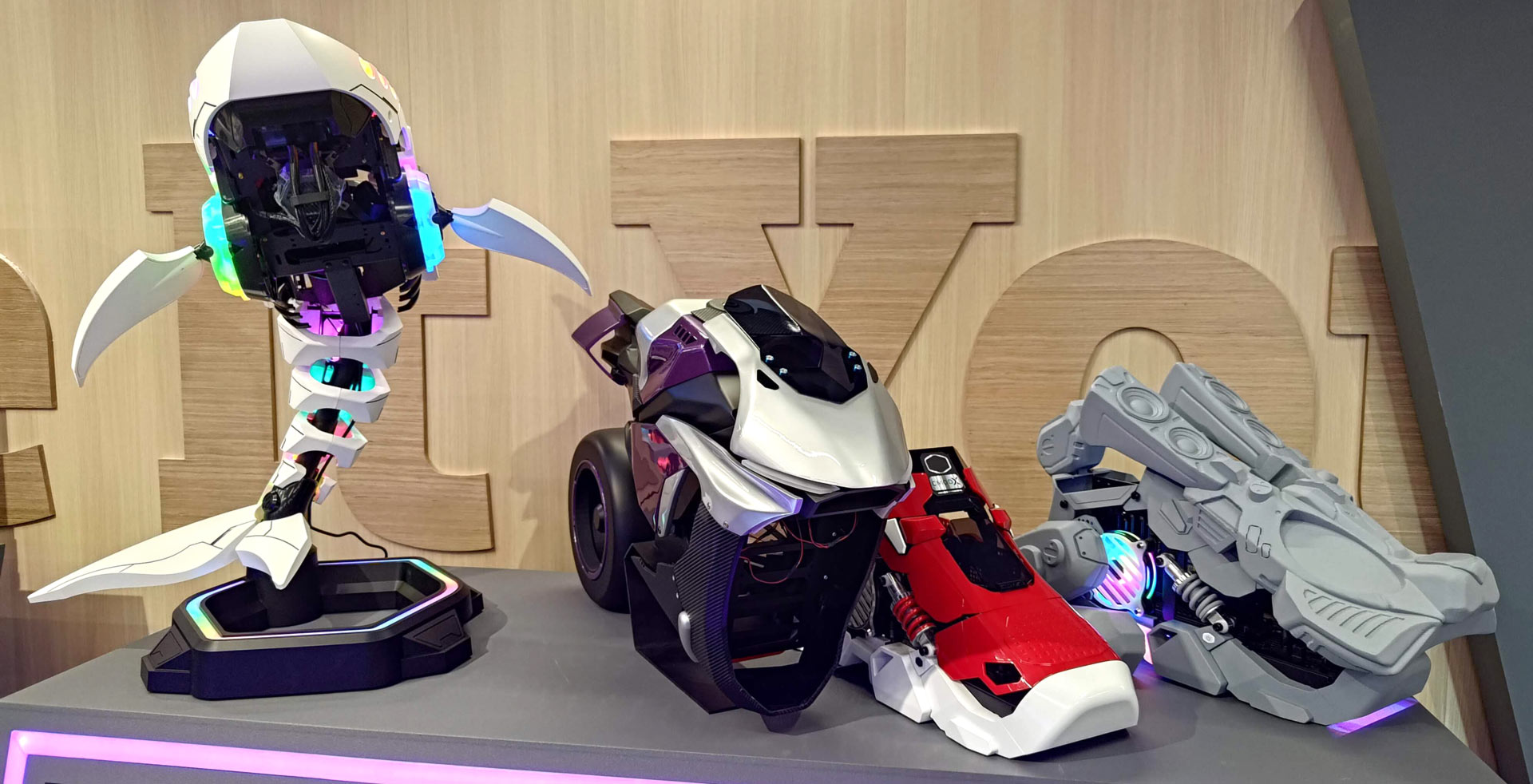
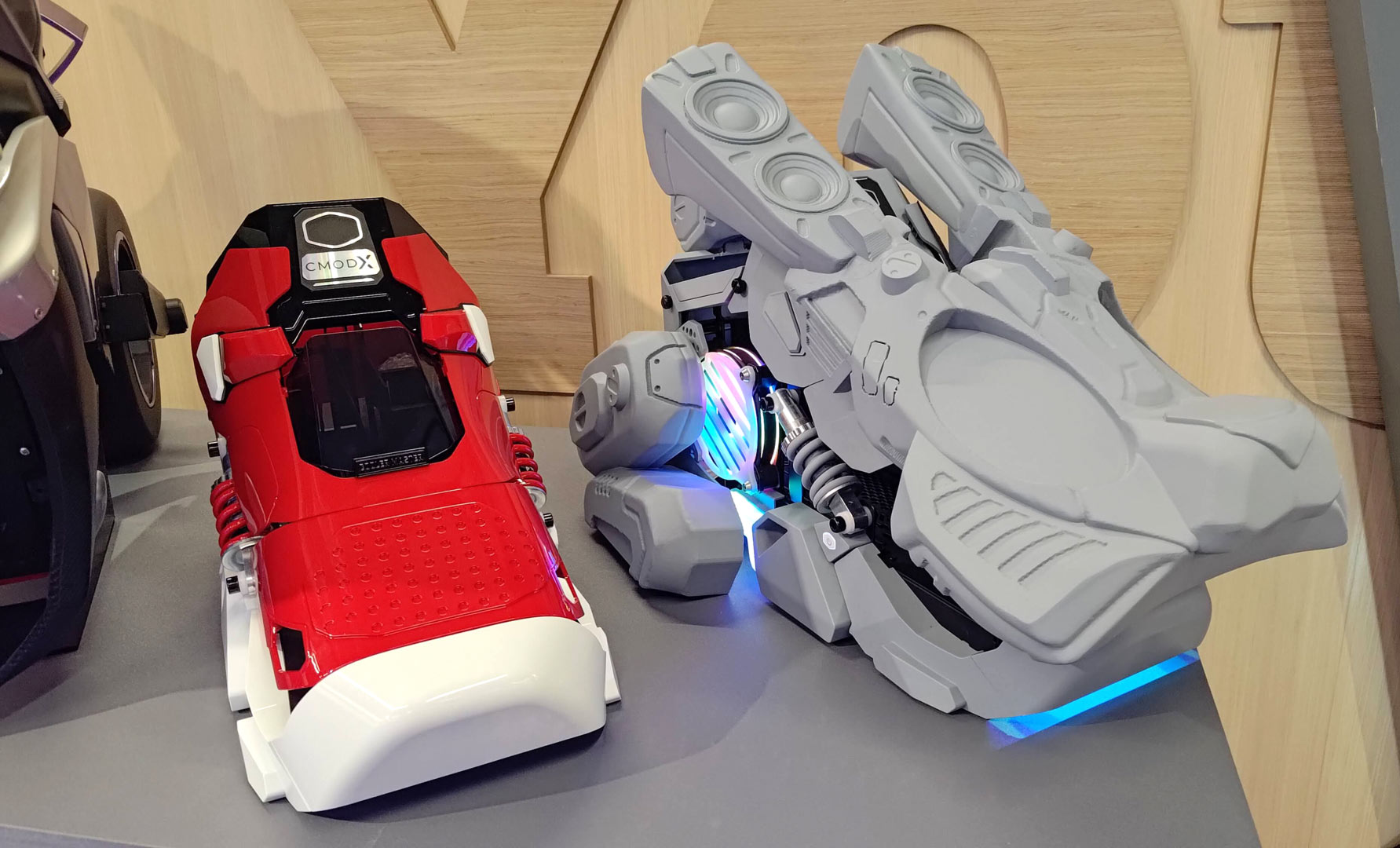
Our visit to the Advanced System Products BU ended with a look around and inside the Cooling X workstation. We saw this at Computex, and only one configuration remains for sale at US$6,999.
In the flesh, it is incredibly rigid and very heavy, but it exudes quality and is pleasingly compact (SFX PSU, Mini ITX). Remember, this design uses custom liquid cooling for the CPU and GPU (an AMD Ryzen 9 7950X3D and Nvidia GeForce RTX 4080), which attach to the thickly ridged aluminum sides to extract heat from inside the case. A pair of 120mm rear fans, positioned just above the 850W SFX PSU, pull air from the case.
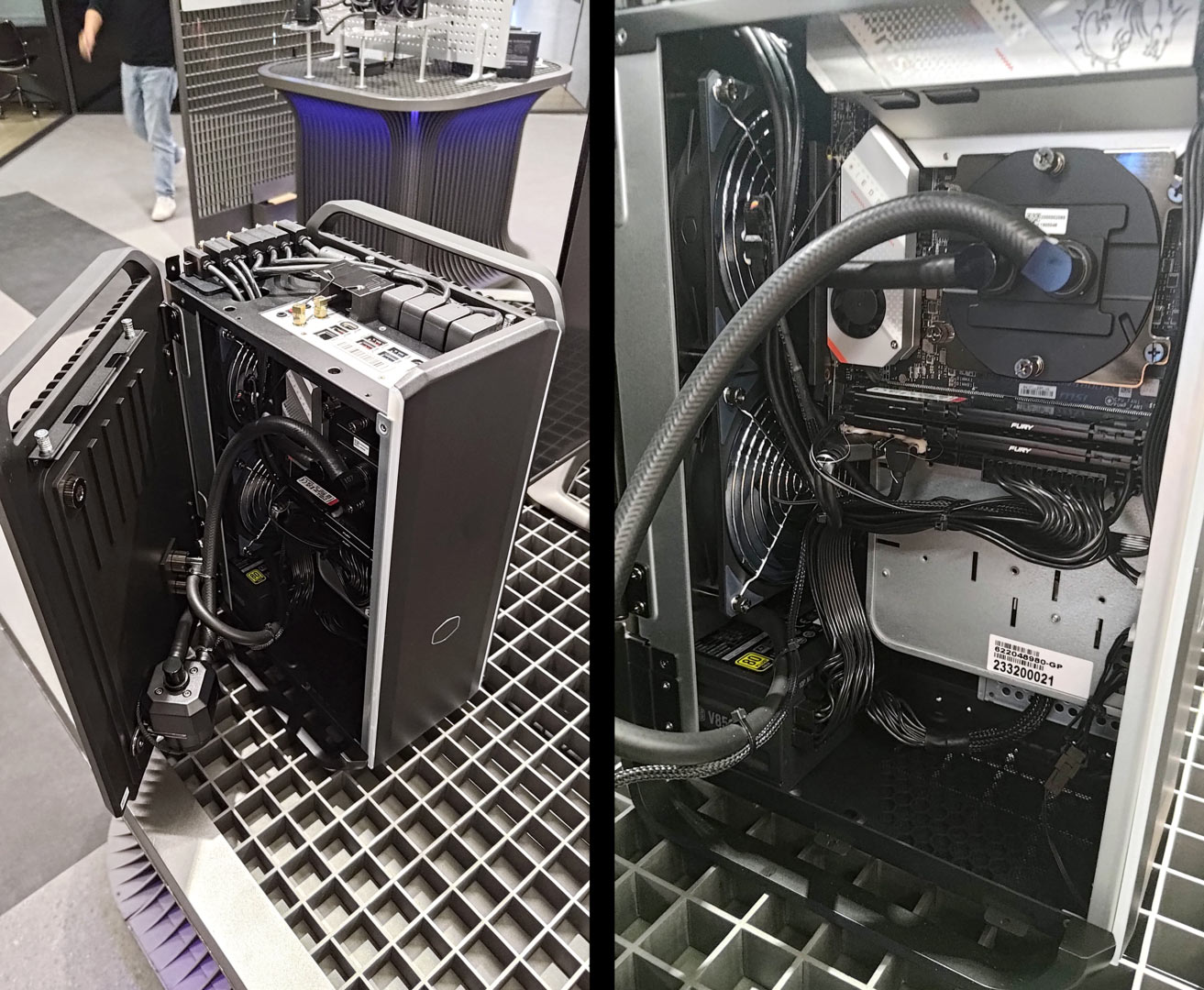
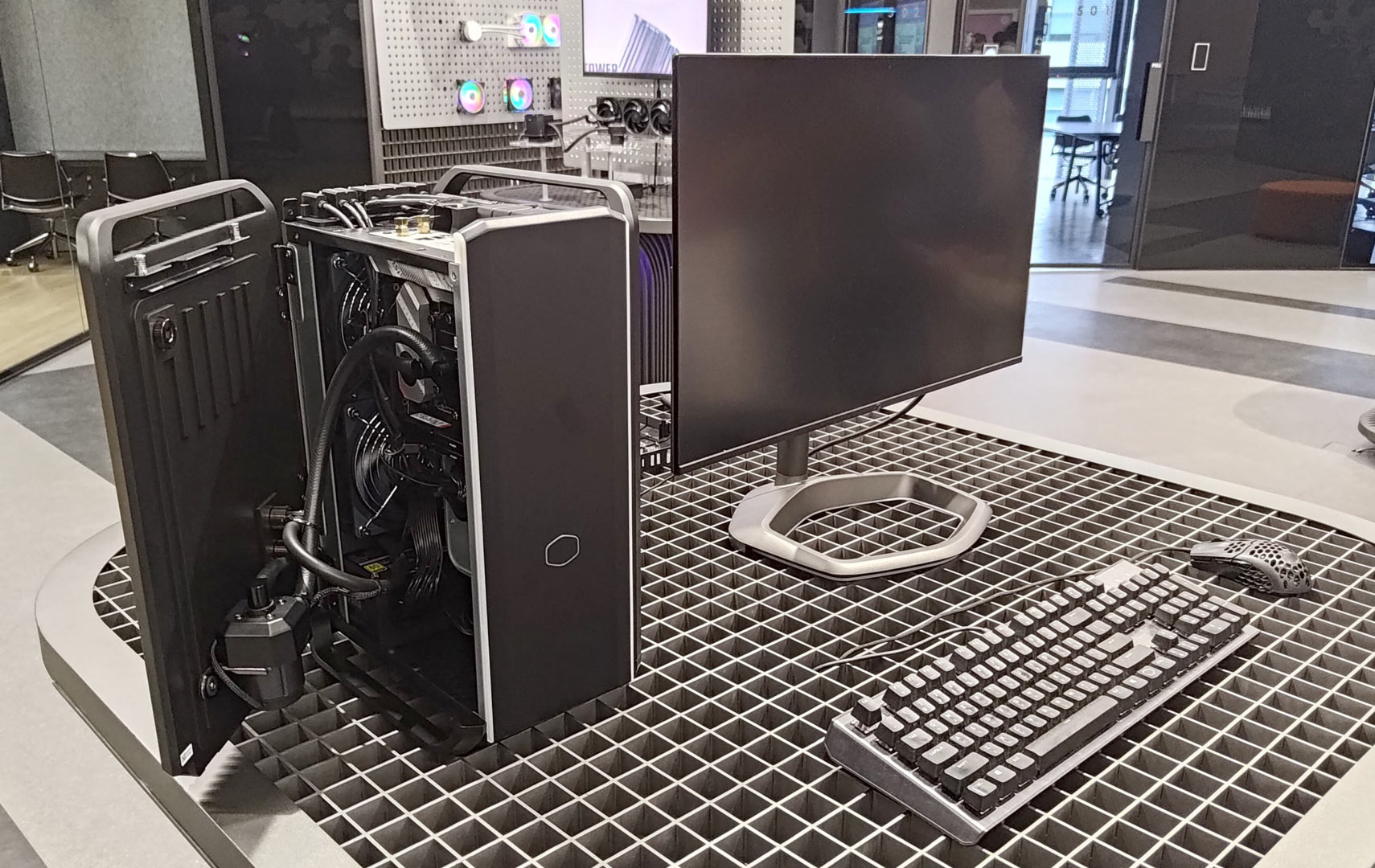
Perhaps the Cooling X pre-built system didn’t make the splash it envisaged. The design team is convinced more interest can be spurred in this pre-built with a few spec changes and optimizations. Hopefully, with a refresh, they can democratize this design and perhaps edge it under $5,000.
Cooler Master interviews and personnel profiles
During our visit to Cooler Master HQ, we spoke to several of the people shaping the company and its most important products. To get to know some of the key people behind the brand, we asked two executives about their backgrounds, their interest in PC DIY and gaming, and the PC cases and components trends they expect to unfold in the coming months.
Carlos Villanueva, Head of Global Marketing
Carlos began his computer industry career in the media, working in the U.S. at outlets such as Fox, IGN, and MTV, but most recently, was in a role at electronics retailing giant Newegg. As a PC gaming enthusiast, Carlos is on the product side of the computing industry with Cooler Master as its Global Marketing Director.
The first PCs that Carlos owned were off-the-shelf Dell systems. In his early PC days, he replaced his pre-built systems with newer pre-builts when games started to get slow or too demanding. His head was turned in the noughties when he got into PC DIY. Carlos says that his first full pre-built system was completed in the Cooler Master Storm Trooper case. According to the Global Marketing Director of Cooler Master, the style and design of a PC are a high priority, and he will typically choose the case before any components.
Carlos predicts small form factor (SFF) systems will get stronger in the DIY segment, and consumers will grow more sophisticated with more diverse demands. Materials choices will be something that can help companies differentiate in 2024. Lastly, he predicts Cooler Master will continue to push PC experiences with systems like Sneaker X, Shark X, and more to come.
Bruce Kao, GM of CASE BU
Bruce has worked at other iconic PC brands, spending a large slice of his prior career as a product manager in the Asus ROG motherboard business unit, as well as developing various Asus ROG AIO liquid cooling series. After Asus, he worked for a spell as a Product Manager at Supermicro, working on the firm’s server products.
After completing an introductory few months at Cooler Master, Bruce became GM of CASE. Perhaps his introductory period provided some insight into possible synergies between Cooler Master departments. It probably isn't any coincidence that we are now seeing more full systems and barebone-style product bundles from Cooler Master.
While the GM of CASE at Cooler Master asserts he has been a “die-hard gamer” for as long as he can recall (with over 8,000 hours charted by Steam), he admits he wasn’t into PC building until he started working in the industry. In this chosen career, he felt duty-bound to deeply understand all the products in the businesses where he worked, and this drive became knowledge and experience.
Of course, there was plenty of opportunity for PC building and refinement while working at Asus ROG. Before leaving Asus, he had certainly become a dedicated PC DIY enthusiast. Bruce’s PC-building skills were evident as he ended up being responsible for every showcase system built for prestigious trade shows like Computex, CES, and more.
Bruce’s product design philosophy is “I only make products that I want to spend money to buy.” This sounds like a no-nonsense foundation for products. But the GM of CASE also let it be known that he still frequently builds gaming PCs to work on innovations and refinements, which he hopes is reflected in all new Cooler Master brand products.







